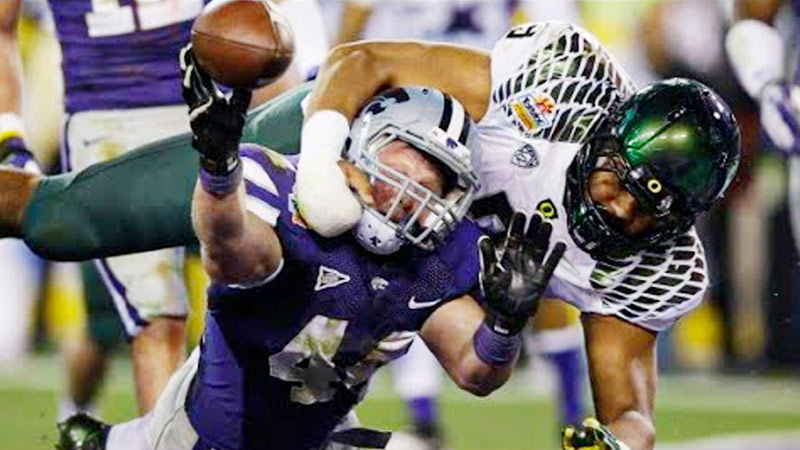In the world of American football, where touchdowns, field goals, and safeties are staples of scoring, there exists a rare and enigmatic phenomenon that perplexes even the most seasoned fans and players—the 1-point safety.
This puzzling play defies traditional scoring norms and adds an intriguing layer of complexity to the game. In this blog post, we dive deep into the intricacies of the football 1-point safety rules, unraveling the mysteries behind its occurrence and exploring its significance.
Get ready to discover the rarest of scoring events and gain insights into how this rule showcases the evolving nature of football’s regulations. So, stay focused.
What Is Football 1-Point Safety?
The 1-point safety is a rare and unusual occurrence in American football, where a team on offense scores a single point as a result of a safety.
This happens when a team is attempting a point-after touchdown (PAT) or a 2-point conversion after a touchdown, and the ball is fumbled or intercepted by the defense and then carried back into the offense’s end zone.
If the defense is then tackled or forced out of bounds in their own end zone, the offensive team is awarded 1 point.
Unlike a traditional safety, which grants 2 points to the defense, this scenario yields only 1 point to the defense. The 1-point safety is exceedingly rare, making it a unique and puzzling aspect of American football’s rulebook.
The History of the 1-Point Safety

The history of the 1-point safety in American football is a fascinating tale of rules evolution and rare occurrences.
This peculiar play has its origins in the game’s early development and has seen a few instances in modern football history. Here’s an elaboration on its history with some key subpoints:
Origins and Rule Development
- The 1-point safety rule has roots dating back to the formation of American football rules in the late 19th century.
- The sport evolved from rugby and soccer, leading to unique rule distinctions, including scoring methods.
- The rulebook eventually included provisions for safeties, which traditionally awarded 2 points to the defense.
Asymmetric Scoring Concept
- American football’s scoring system is inherently asymmetric, with different point values for various plays.
- Touchdowns are worth 6 points, followed by extra point attempts (1 or 2 points) and field goals (3 points).
- The 1-point safety adds another layer of complexity to this system by allowing the defense to score 1 point from an offensive attempt.
Rare Instances and Historical Occurrences
- The 1-point safety is extremely uncommon and has rarely been observed in the history of the sport.
- One of the earliest recorded instances dates back to a college football game in 1923 involving the University of Texas and Texas A&M University.
- In more recent times, the 1-point safety has occurred in significant matchups, capturing the attention of fans and experts.
Rulebook Clarity and Interpretation
- The wording of the rulebook regarding the 1-point safety has evolved over time, leading to debates and discussions among officials, players, and fans.
- Interpretations of the rule have sometimes resulted in confusion during games, as officials must accurately assess the situation and apply the rule accordingly.
Complexity and Strategic Implications
- Coaches and players need to understand the intricacies of the 1-point safety rule and its potential strategic implications.
- In situations where a team is trailing by 1 point late in a game, attempting a 2-point conversion could potentially lead to a 1-point safety, further complicating decisions on game strategy.
Uniqueness and Game Oddities
- The rarity of the 1-point safety adds to its intrigue, making it a topic of fascination among football enthusiasts.
- Its occurrence demonstrates the unpredictable nature of the sport and the continuous evolution of rules and gameplay.
1-Point Safety Rules in Football

The 1-point safety rule in American football is an uncommon and often misunderstood rule that involves scoring a single point on a safety play.
Here are the key rules and conditions that govern the occurrence of a 1-point safety:
Scoring Team Attempting Extra Point
- The 1-point safety typically occurs when the scoring team attempts an extra point (PAT) or a 2-point conversion after scoring a touchdown.
- If the offense loses possession of the ball during the extra point attempt, and the defense gains possession and carries the ball back into the end zone, a 1-point safety is possible.
Ball in Possession of the Defense
For a 1-point safety to be possible, the defense must gain possession of the ball during the extra point attempt. This can happen through a fumble recovery, interception, or any other means.
Defense Returning to the End Zone
After gaining possession, if the defensive player carrying the ball is tackled, forced out of bounds, or otherwise prevented from advancing, in their own end zone, a 1-point safety is awarded to the offense.
Awarding the Point
In the event of a 1-point safety, the scoring team (the offense) is awarded 1 point. This is an unconventional situation where a team scores a point on what is traditionally a defensive play (safety).
Origin of the Rule
The 1-point safety rule originates from the early rulebook of American football and adds to the unique scoring dynamics of the sport.
Infrequent Occurrence
- The 1-point safety is extremely rare and has only been observed in a handful of instances throughout the history of football.
- Due to its rarity and complexity, players, coaches, officials, and fans may not be familiar with its nuances.
Rules Evolution
The wording and interpretation of the rule have evolved over time, with adjustments to clarify its conditions and applications.
Game Strategy Considerations
The possibility of a 1-point safety can impact game strategies, especially in critical situations where teams are deciding whether to attempt a 2-point conversion or a PAT.
Kickoff by the Scored-Upon Team
After a 1-point safety is scored, the team that was scored upon is responsible for kicking off to the opposing team from their own 20-yard line.
Who Kicks Off After a 1-point Safety?

After a 1-point safety, the team that was scored upon is required to kick off to the opposing team. The team that scored the 1-point safety is not responsible for kicking off. The team scored upon must perform a free kick, which can be a punt, dropkick, or placekick, from their own 20-yard line.
It’s important to note that the use of an artificial or manufactured tee is not allowed for this kickoff; the ball must be kicked directly from the ground or held by a teammate.
This kickoff marks the resumption of play after the 1-point safety and gives the scoring team an opportunity to start their offensive possession.
How to Get a 1-point Safety?
A 1-point safety in American football is a rare and unusual occurrence, as it involves specific conditions during an extra-point attempt by the scoring team. To get a 1-point safety, the following steps must be followed:
Extra Point Attempt
The scoring team must score a touchdown and then attempt an extra point (PAT) or a 2-point conversion.
Defense Possession
During the extra point attempt, the defense must gain possession of the ball. This can happen through an interception, a fumble recovery, or any other means that result in the defense getting control of the football.
Carrying into the End Zone
Once the defense has possession of the ball, a defensive player must carry the ball back into the end zone that the offense is defending. This means the defensive player must move in the opposite direction of the field, back toward the end zone where the offense started the play.
Tackle or Exit from End Zone
If the defensive player carrying the ball is tackled, forced out of bounds, or otherwise prevented from advancing in their own end zone, a 1-point safety is awarded to the offense.
Scoring the Point
When the criteria are met, the offense is awarded 1 point for the 1-point safety. This point is added to their overall score.
It’s important to note that the 1-point safety is exceedingly rare and not commonly encountered in football games. It requires a unique set of circumstances during an extra point attempt, and the timing and coordination of these factors are uncommon.
Significance of 1-point Safety in American Football
The significance of the 1-point safety in American football lies in its rarity and its ability to capture the attention of fans, players, and analysts due to its unusual nature. Here are some key points highlighting the significance of the 1-point safety:
Uniqueness and Anomaly
The 1-point safety is an exceptionally rare occurrence in the game, making it an anomaly that stands out from the more common plays and scoring events. Its infrequent nature piques interest and generates discussion.
Rulebook Complexity
The existence of the 1-point safety showcases the depth and complexity of American football’s rulebook. It reflects the game’s rich history of rule development and evolution over time.
Strategic Considerations
The potential for a 1-point safety can impact game strategies, especially when teams are deciding whether to attempt a 2-point conversion or a traditional extra point. Coaches and players may need to weigh the risk of such an unusual outcome.
Historical Significance
The few instances of 1-point safeties that have occurred in the history of the sport are etched into the football archives. These moments become unique records and footnotes in the narrative of the game’s evolution.
Engaging Fans
Unconventional plays like the 1-point safety add excitement to the game and engage fans by presenting unexpected outcomes. Fans are intrigued by the rarity of the event and the challenges it poses to their understanding of the rules.
Debate and Discussion
The complexity and rarity of the 1-point safety can spark debates and discussions among fans, experts, and analysts. Interpretations of the rule, the circumstances under which it occurs, and its strategic implications can all be topics of conversation.
Testament to Adaptability
The existence of the 1-point safety demonstrates that even within a well-established sport like American football, there is room for unique events that challenge players and officials to adapt to evolving situations.
Rulebook Evolution
The history of the 1-point safety reflects the evolution of the sport’s rulebook. Rule adjustments and clarifications have been made over time to ensure that this unusual play is properly addressed and understood.
FAQs
What is a 1-point safety in football?
A 1-point safety is a unique scoring play in American football where the scoring team attempts an extra point (PAT) or a 2-point conversion after a touchdown.
If the defense gains possession of the ball during the attempt and carries it back into their own end zone, they can be tackled or forced out of bounds to award the offense 1 point.
How rare is the occurrence of a 1-point safety?
The 1-point safety is exceptionally rare in football and has been documented only a few times in the sport’s history. Due to its specific conditions and the intricacies involved, it remains a captivating anomaly that surprises both players and fans when it happens.
Can a 1-point safety occur during a regular safety play?
No, a 1-point safety can only occur during an extra-point attempt by the scoring team. A traditional safety play, where the defense tackles an offensive player in their own end zone, still awards 2 points to the defense.
How does the 1-point safety affect game strategy?
The potential for a 1-point safety can impact game strategy, especially when teams are deciding whether to attempt a 2-point conversion or a regular PAT. Coaches and players may need to consider the risk associated with attempting an extra-point play that could potentially backfire.
What does the 1-point safety reveal about the game of football?
The existence of the 1-point safety showcases the complexity of American football’s rulebook and its capacity for unique scenarios. It underscores the sport’s rich history, evolving rules, and the excitement that unconventional plays can bring to the game.
Wrapping Up
As we conclude our journey into the depths of football’s 1-point safety rules, we’ve unveiled a rare gem within the world of scoring plays. This anomaly reminds us that even in a game as established as American football, surprises still await in the intricacies of its regulations.
The 1-point safety stands as a testament to the sport’s evolution and its ability to captivate our imaginations with the unexpected.
So, the next time you watch a football game and hear the term “1-point safety,” you’ll know that you’ve encountered one of the most intriguing and puzzling aspects of the sport. Thank you so much.







